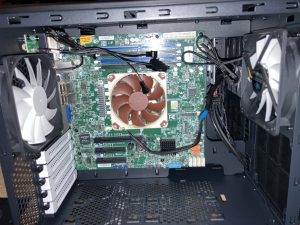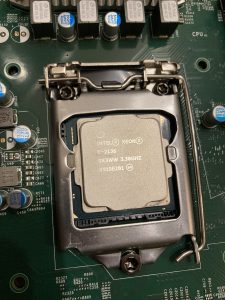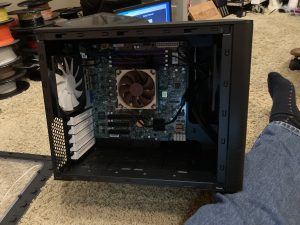DIY NAS Build – Network Attached Storage
Your house may have numerous computing devices which means you probably have data you want backed up. Yes, there are all manner of cloud services (Google Drive, Dropbox, iCloud, etc.) that you can utilize and they are indeed handy but your data now exists on SOMEONE ELSE’S COMPUTER. And maybe that is what you want because there is something to be said for off site back up’s. If there is a natural disaster and something tragic happens then you may lose all your data if it is stored locally. We’re going to explore building our own DIY NAS.
That is a subject all in itself but back when I was working I built two small, identical NAS servers and just took one to work. Because there was no private internet connectivity besides a phone hotspot, I would just bring one from home and take the other one back home to update it. Again, off site back ups are an entirely different subject.
Another very common reason you might want a dedicated locally controlled server would be to rip all those DVD movies, and CD music you have to a media server. Or a NAS server can act as storage for your security cameras (to hell with paying some company a monthly fee for your video) or for DVR. I have a couple favorite old shows that I record currently from over the air (OTA) TV to my media server.
And if you build a device that is probably going to be on 24/7 you probably should exploit the heck out of it and make it do stuff. Let’s build a NAS, shall we?
Prep Work
Before we start I strongly recommend that you take the time to check out a couple of web sites. In my opinion the information on these sites is required reading before building a NAS.
- briancmoses.com – The de facto standard in NAS building.
- Butter, What?! – Trust me, there is an epic page on NAS building.
Also before I start with the build, I’ll discuss the current things I find useful about having a NAS. At some point when you add a lot of functionality to Network Attached STORAGE you can probably, safely call it a Home Lab Server. Call it either one. Here is what I do:
- Media server – I use Plex and Emby. Both servers are hooked to an HDHomerun network TV tuner and I can watch live TV from my area ANYWHERE. Plex and Emby also house my favorite movies locally. Anymore I just rip the movies that you can’t find on line without paying if I have the DVD. The old Steve McQueen movie Bullitt is a prime example. I watch that movie every couple of years but it isn’t free anywhere (legally).
- Media server part Deux – I use LogitechMediaServer for streaming music and playing locally stored music. You can hook a Raspberry Pi to any stereo or AV system or TV HDMI and stream internet radio or locally stored music. I have about 4 GB’s of music. Eclectic, out there stuff. With Spotify and/or Tidal and TuneIn radio you can hear just about anything.
- Home Automation – The excellent automation program, HomeAssistant can be run from your NAS.
- MQTT server – For home automation using Machine to Machine protocol (MQTT) is HUGE. Most of my automated devices are flashed with an Open Source firmware called Tasmota and are connected to my MQTT server.
- Zwave and Zigbee hub. Both are hubs for controlling automated devices such as switches, outlets, bulbs, etc. Your NAS can be a hub. Remember going into Lowes and seeing IRIS smart devices? They sold an Iris hub (proprietary) and one night Lowes just said Iris was going POOF! If you bought Iris stuff from Lowes you are simply out of luck.
- Handbrake – For ripping movies and storing them locally
- Motioneye – this is a program for viewing security camera feeds. Also your NAS can store your security cam 24/7 footage for FREE.
- Virtual Machines – I’m an OS geek. I love different distributions of Linux, FreeBSD, and I love seeing old OS’s like OS2 Warp or the more modern Haiku project. Here’s a good example. Years ago I bought this computer drive bay scanner for photos. Stick a photo in the bay and it sucked it in like a CD and scanned the photo and digitized it. It was AMAZING. It worked with like Windows 95 and maybe Windows 98 and then it was abandoned driver wise. If I still had that drive (it died) I’d darn sure set up a Windows 95 Virtual Machine and use it TO THIS DAY.
Enough sales pitch on NAS devices. You need one. You want one.
Considerations
Depending on WHAT YOU DO will depend on what kind of hardware you need. If you only want to back up a TB or 2 of data …………don’t build a freaking $2000 Home Lab server. If you want to run 15 virtual machines with all your favorite OS’s………..don’t build a Raspberry Pi NAS.
One more thing to think about. If your server is on 24/7 and you don’t need a massive Home Lab server your NAS should SIP power, not gobble it. State of the art CPU’s and an array of cheap mechanical hard drives have the potential to consume a lot of wattage. The more watts you run, the higher your electricity bill will be.
Missions
As per my requirements above you can see I would benefit from a super fast computer with lots of memory. Ripping movies and running virtual machines takes quite a bit of CPU cycles and memory. However, comma, I currently run a pretty low power machine based on an Intel Atom CPU with 4 cores @ 2.2GHz. The board is an AsrockRack C3558D4i-4L. Throw in 16GB of decent RAM and a few cheap hard drives and this is serious bang for the buck. As far as building a good solid QUIET and CAPABLE server this is very ECONOMICAL. I doubt MOST people would need more and I imagine for MOST people this would be overkill anyway.
The Gods of NAS building might scoff at my Intel Atom based server board but let me just say this:
With this Intel Atom server I have never once uttered the words “this damn slow ass server”. It has always been enough. It doesn’t choke. Also, it has never let me down. I only run one virtual machine at a time and I DVR record TV shows with no issues. Streaming across my home network is fine. Having a super computer will just let me hardware transcode higher resolution stuff on Plex or Emby. Having said that, I don’t know if I NEED to hardware transcode higher resolution stuff on Plex or Emby. Your mileage may vary.
The Build
I’m upgrading though. Here’s the new build:
[table id=4 /]

I kind of spared no expense here but I did save about 40-50% by buying a used CPU. I found an eBay seller with a couple thousand transactions and a 100% feedback so I feel pretty confident about the purchase.

Xeon E-2136 CPU
You could also cut costs big time by buying consumer grade hard drives. The word RAID as it relates to a “Redundant Array of INEXPENSIVE Disks” still holds true.
Also I cut some corners with the RAM. The specs of the RAM are correct and the price is really cheap but sometimes you get what you pay for. We’ll see how it works out. I will build up a back up server and nothing I do is SUPER critical anyway so if the RAM craps out I’ll be able to work around it.
The Fractal Node 804 case is bigger than I thought it would be but I’ve been used to Mini-ITX motherboards in my previous builds. It’s fairly huge.

Fractal Node 804
Disks
You might notice I have an 8TB drive in the mix. I run UnRaid for my server OS. Unraid needs a parity disk that is larger than any other disk in the system. If you are running TrueNAS you can forgo the parity disk which will save some cash. Also while you can boot from an SSD most folks run TrueNAS from flash drives. Put two of them in for redundancy should one fail. $14 worth of flash drives with TrueNAS will eliminate that SSD drive. Anyway, depending on your OS of choice your HDD requirements can vary. Unraid also needs a fast cache drive, hence the SSD. You won’t NEED that with TrueNAS.
I also see that I could get a Motherboard, CPU, and memory (albeit not these particular ones) really cheap on Facebook Marketplace. There are several military installations near me and seemingly the fine young Patriots are always upgrading their computers and selling the old parts. If money were a strong consideration I’d shop Marketplace for a good motherboard and CPU and memory deal and if necessary I could add a SATA card for more ports. Again, a generation or two or three old component mix is still maybe overkill for what you may be doing. An Intel i3 is probably WAY more than enough CPU power, and again my Intel Atom motherboard is not nearly as powerful as an old i3 chip. All I’m saying is that used parts are a viable solution to keeping costs low and bulding a decent NAS.
One thing I think you should watch out for is boards that require a graphics card. Integrated graphics is good enough for a NAS and generally way cheaper. Once you boot up your NAS operating system (i.e. Unraid, TrueNAS, OpenMediaVault, etc.) you are going to manage the device from a web browser on your network. Speedy graphics are not needed and just add cost to your project. So if you buy a cheap motherboard combo on Marketplace and get it home you may find you need to buy a graphics card before you can boot it.
I recommend sticking with motherboards DESIGNED for server applications. Essentially it will have at least 4 memory slots, several SATA or PCIe slots and integrated graphics. Some will have a chip soldered on the board as well. While this limits you from upgrading it generally reduces the cost and generally allows for lower power consumption. Trade offs.
If you try to save money and buy some old gaming parts you might see your money savings go poof after a year of electric bills.
Another consideration is NOISE. My AsrockRack server has passive cooling which is great but of course you need fans spinning on those hard drives. Putting a noisy server by your bed is probably not a great idea. I have a workshop at one end of the house with frickin’ laser beams and 3D printers and exercise equipment and a bit of noise is A Okay in that space.
So let me summarize the key points in your server build:
- Don’t spend a ton of money for state of the art stuff if YOU DON’T NEED IT or know how to exploit it and run all the cool server programs.
- State of the art stuff consumes more power which costs you money in the long run.
- Servers can produce a lot of fan noise. Choose your server location so as not to disrupt your lifestyle.
- The OS you select may require additional hard drives for parity and cache thereby running up your costs a few hundred dollars. Decide what you are going to do before you start buying hardware.
- Don’t be scared to buy used components. NAS building is not cheap. Hard Core networking geeks are always snatching up old servers, especially commercial grade stuff. Yesterdays old rack server with an Intel Xeon chip is gonna give you way more CPU power than you probably need. You would be surprised how many local businesses sell their old rack mount computer servers.
- Have fun and learn and organize your digital life.
Some GOTCHAS:
Supermicro has a unique BMC or IPMI password now. It used to be ADMIN/ADMIN. Now there is a sticker on the board and CPU dust cover. It has two entries.
BMC: xxxxxxxxxxxxx
PWD: xxxxxxxxxxxxx
That would lead you to believe that BMC is the user name and PWD is the password. They have a whole freaking manual for BMC and IPMI. While it talks about the unique password NOWHERE DOES IT SAY THAT THE USER NAME IS ADMIN. Grrrrrrrrrrrrr. Took me a bit to figure it out.
The Supermicro board I used does NOT have PCIe connectors on the board. There are 6 SATA slots and that is it. To expand you need to to buy an actual PCIe card. Not a dealbreaker but my AsrockRack Intel Atom boards have 2 built-in PCIe boards. They also come with PCIe to SATA cables. I can add 8 more drives to them. Fortunately I have will just be running 6 disks (including the optical drive) with no desire to really build beyond that.
Make sure your power supply has enough SATA power connectors. My first power supply only had 4 SATA power connectors. Sure you can get adapters to turn 4 pin MOLEX connectors to power SATA………..but why? Just get a power supply. I added a modular power supply to my rig and a big advantage to that is only installing the cables you NEED. Makes for a much less busy, and cleaner build.
Yeah, I spent a fair amount of cash on this server but it’s flipping awesome, somewhat future proof for a while and I will use my old rig as a back up server and a platform to experiment on. Anyway my Unraid server project is done, and it is perfect for managing my digital life and media server needs.
